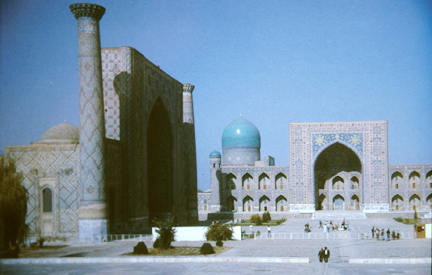
Registan, Samarkand, 1415 CE, Glazed Tile and Brick
ART 198 - HISTORY OF WORLD CERAMICS
| Built by the grandson of Timur, Ulugh-Beg, Registan (literally, Place of Sand) in Samarkand, is the first of its kind in Islamic urban planning. The reconstructed central square can be seen in the contemporary photograph at right. Originally the complex contained a Madrasa (religious school), a Mosque, marketplace, and palace buildings. Of these, only the Madrasa survives. Its elaborate entrance portal is composed of an interlocking grid of mosaic tile and stone inlays, crowned by a field of shining stars. It is the height of Timurid architecture. The reconstructed square gives us only a glimpse of the grandeur of this court. A contemporary writer, Babur, of India (one of Timur's conquered lands), wrote in 1450 that Registan 'possessed pavements made in all sorts of mosaic, and hot public baths unlike any other known. The Mosque is called the Carved Mosque because its ceilings and walls are covered with Islamic patterns and 'Chinese' pictures formed of inlaid wood.' The rulers and their court would have been richly dressed in the finest embroidered silks and jewelry, seated on the finest carpets and pillows, amidst floors, walls, and ceilings covered with dizzying patters of glazed and lustered tile and inlaid woods and ivory, lit by the light of flickering candles and lanterns, creating a 'shimmering world,' in the words of Babur. | Registan, Samarkand, 1415 CE, Glazed Tile and Brick |
|
|